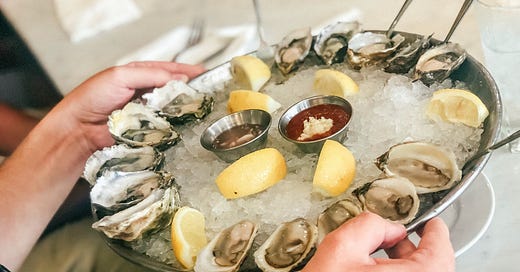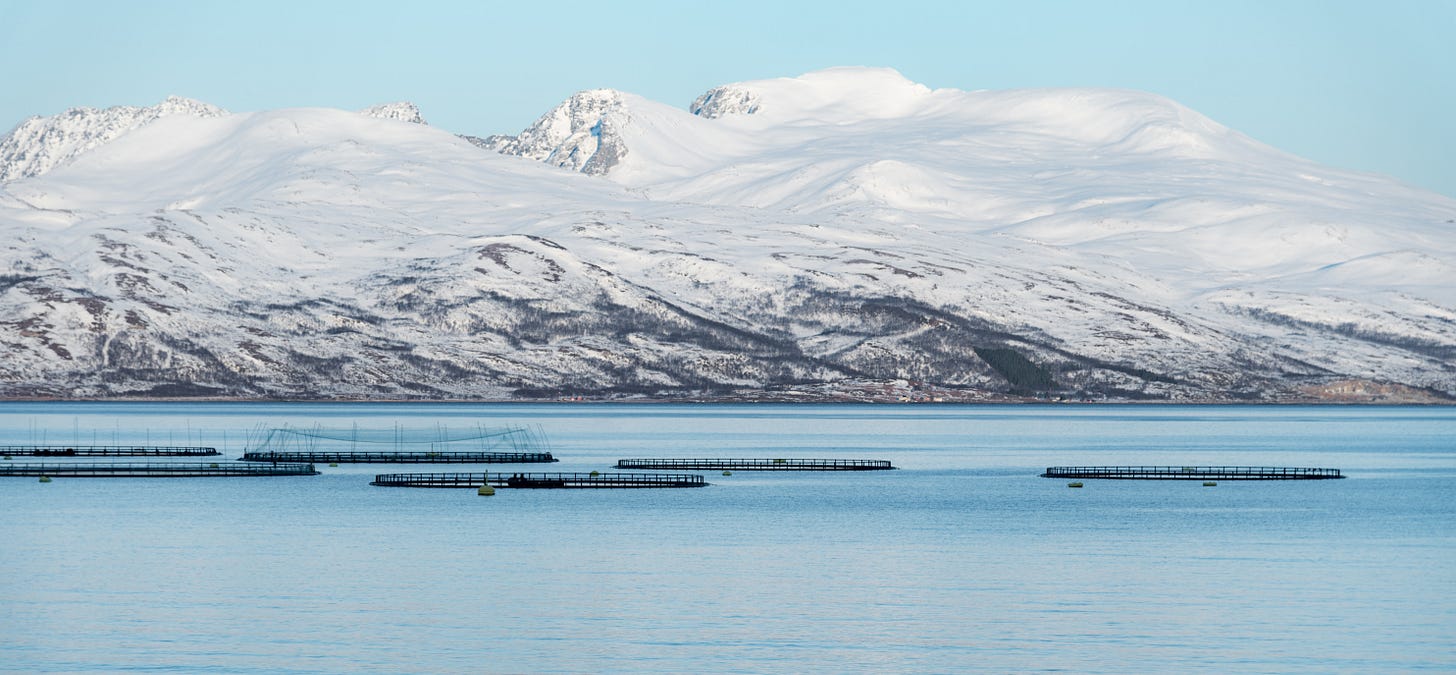How the impacts of fish farming are changing
Takeaways from a two-decade review of global aquaculture.
Attempting to choose responsibly-sourced fish almost always means getting into murky waters, and the question of farmed vs. wild is no exception.
For a long time, fish farming had a horrible reputation, and most environmental experts and organizations recommended wild-caught across the board. But as overfishing has depleted wild fisheries around the world and aquaculture systems have advanced, the tides have started to turn.
And last week, a team of researchers provided new insight into how fish farming is (and isn’t) changing in terms of its environmental impacts, via an article published in the journal Nature that reviewed two decades of industry developments.
I was excited to dig into the review to see how it aligned with reporting I did last year for Civil Eats on a push to open up US waters to “offshore” fish farming. While working on that story, I was surprised to learn that some organizations focused on protecting the oceans were supportive of this open-ocean style of farming fish, because it had the potential to take pressure off of wild fisheries and to solve for some of coastal fish farming’s problems, like waste accumulation and sea lice. Advocates also talked about how feed conversions have gotten better and systems have been improved to limit escapes (although they do still happen). Other environmental groups are still vehemently opposed to the idea, but there’s nuance now that wasn’t there before.
“I was very opposed to fish farming in my cod book and earlier,” Mark Kurlansky, the author of Cod, told me last year when I interviewed him about his new book on salmon. “I still think it’s very harmful, but I think that we need to figure out how to make it work.”
One reason is that the issue has also morphed into a climate conversation, since fish farming produces lower greenhouse gas emissions compared to most land-based animal proteins. (That’s without even taking into account bivalves like oysters, clams, and mussels, which are basically climate-perfect foods.)
So, I pored through the review to pull out some of the biggest takeaways. One thing to note before we dive in is that this review only considers environmental impacts. It doesn’t get into long, opaque global supply chains that make it nearly impossible to know what you’re actually eating. It doesn’t ask questions about who is producing the seafood and whether inequalities or labor issues are involved. (Multiple investigations have found forced labor and human trafficking in Asia’s shrimp industry, for example.) And it doesn’t address another question that I think will get more attention in the coming years: How do we think about animal welfare in fish farming?
Here’s what it can tell us about what fish farming looks like today.
Some background:
Aquaculture is growing like crazy. Between 1997 and 2017, production more than tripled in volume, to 80 million tons. That’s compared to 92.5 million tons of seafood from wild fisheries in 2017. Fish farming in Asia accounts for 92 percent of that production, with China far-and-away the leading country.
The farming of freshwater fish in inland ponds in Asia accounts for a large share of production but gets less attention because so much of globally traded seafood is salmon and shrimp. “Freshwater fish have a central role in the global production, contributing more than any other aquaculture sub-sector to the total (live and edible) volume, rural livelihoods, and food security during the past two decades,” the researchers write. “Because most farmed freshwater fish do not enter the global market, however, there is currently little impetus for producers to engage in sustainable practices with recognized ratings or certification.”
And the biggest takeaways:
1. Fish feed has improved, but it’s still the biggest sustainability issue
If the best case for farming fish is to leave wild fish alone, fish food is where that argument starts to fall apart. For a long time, the aquaculture industry has been depleting the ocean of little “forage fish” like menhaden and anchovies in order to feed the bigger fish they’re farming. Those fish are at the bottom of the food chain and ocean ecosystems need them. There are many different approaches to addressing this, one of which is to improve the feed conversion ratio, AKA how many kilograms of wild fish it takes to produce a kilogram of farmed fish.
Here’s the good news from the review: Even though the production of fish tripled between 2000 and 2017, the amount of forage fish caught annually to make fish food has decreased, from 23 million tons to 16 million tons. “Four major developments along the aquaculture supply chain have helped to reduce the dependence on wild fish resources since 2000: rapid growth in omnivorous species production; improved feed conversion ratios (FCRs) for all fed species; higher use of alternative protein and oil ingredients in feed; and increased production and use of fishmeal and fish oil from fish-processing wastes and bycatch,” the researchers wrote.
Improved feed conversion ratios are a big development, and the fact that trimmings now make up about a third of the fish used to make fishmeal globally (half in Europe!) is huge. Basically, many companies have figured out how to use the bits of the fish that would have gone into the trash, so they’re simultaneously cutting waste and reducing dependence on forage fish.
But there are two caveats. The first is obvious: there’s still a lot of forage fish—probably too much—being caught to feed farmed fish, especially in Asia. The second is complicated: One of the ways the industry has cut the amount of fish in feed is by adding plant ingredients like canola oil and soy protein. That substitution can mean replicating some of the issues we’ve seen with growing crops like corn and soy to feed land animals. “Studies modelling fishmeal replacement with plant-based proteins (for example, soy protein concentrate) in shrimp and salmon show potential increases in ecotoxicity from fertilizer and pesticide use, rising pressure on freshwater and land resources, and heightened carbon emissions and biodiversity loss from forest clearing—particularly in Brazil,” the researchers write. Not to mention that just like feeding grains to cows changes the fatty acid profile of beef, feeding canola oil to salmon changes the fatty acids in the fish, which could affect its health benefits.
2. Bivalves need a boost
According to the review, global production of farmed “mollusks”—which includes oysters, clams, mussels, and scallops—grew at an annual rate of 3.5 percent between 2000 and 2017. It’s an increase, but it’s much lower than the increase in finfish and crustaceans.
This is disappointing because bivalves just may be the most climate-positive food group on the planet. That whole long explanation I just provided on fish feed? Not even relevant with bivalves, since they require no feed at all. No forage fish, no crops, no resources to produce the feed. They don’t need space to swim around, and they can’t escape and hurt wild populations. Oh, and to top it off, they provide other ecosystem benefits via water filtration and habitat.



3. Recirculating and open-ocean fish farms present new opportunities
The researchers identify recirculating aquaculture systems that reuse water in land-based facilities and offshore aquaculture as both having “promising growth potential.” But each has its own set of challenges.
Recirculating systems use less water but “are constrained by large energy requirements, high production costs, waste disposal challenges, and risk of catastrophic disease failures.” (Just this week, a large recirculating fish farm in Florida blamed a “mass mortality,” which one trade outlet calculated meant half a million salmon died, to a filter malfunction.) Open-ocean systems can minimize land and water use and reduce nutrient pollution and disease issues, but making sure they’re installed in the right places is both tricky and crucial. They are also extremely expensive to build.
In the end, aquaculture will most definitely continue to expand, so questions and insights like the ones presented in this review will become even more important. You know what will help you process all the information? Go eat some oysters. They’re good for your brain…and basically everything else.
A side of policy
Little bites. While everyone else who cares about what kids are eating was watching Waffles + Mochi this week, I was tuning in to the Senate hearing on Child Nutrition Reauthorization. Lucky me! This process is referred to on Capitol Hill as “CNR,” and it’s supposed to happen every five years to update and fund the various child nutrition programs run by the Department of Agriculture, especially school meals. Congress has failed to take up CNR in over a decade, so it’s more than five years overdue. The hearing was essentially the kick-off of a process that will include lots of negotiations. One thing seemed clear, though: Senators on both sides of the aisle were up for taking it on to tackle the “dual challenge of obesity and hunger,” said Senator Debbie Stabenow (D-MI). “Feeding kids is not and should not be a partisan issue.”
Still hungry?
Old friends, new story. On this week’s episode of The Farm Report, I interviewed farmer Becky Fullam—of Old Ford Farm in New York’s Hudson Valley—about what the past year has been like and why she’s hoping customers continue to support small farms like hers long after the pandemic is behind us. This was a special interview for me because Becky is not only a smart farmer with a great story. We also grew up together and were very close friends as kids. Just a few months ago, she saw my byline on a story and reached out to tell me she had become a farmer, and we were reconnected just like that. Look for episode 418 wherever you listen to podcasts or listen on Heritage Radio, here.
Currently devouring
Taking the temperature. Eater published this series of articles last week on how climate change is affecting—and will continue to change—how and what we eat. I was initially put off by the first headline, which asks whether the climate crisis will make truffles cheaper (only the most critical questions, right?). But the story itself is actually an interesting look at the complicated ways in which changing weather patterns will influence growing regions and the people in them. There are also stories on meat, lettuce, olive oil, wine, and jellyfish.
Actually eating
Unlike everyone else who uses the internet, the pandemic made me want to bake less, not more. So I think it’s a good sign that I felt like making oatmeal chocolate chip cookies this week. Morris had his eye on this one.
Let’s be friends
Follow me on Twitter and Instagram to continue the conversation. See you next week!







